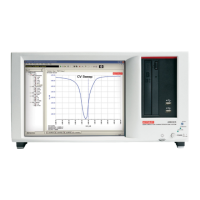4200-900-01 Rev. K / February 2017 Return to Section Topics 3-27
Model 4200-SCS User’s Manual Section 3: Common Device Characterization Tests
Figure 3-24
CVU Frequency Sweep (step) output
How to perform a Pulsed I-V test on my device
There are a few ways to perform Pulse I-V testing with the 4200-SCS. One
method uses the 4225-PMU with or without the 4225-RPM. The PMU is an
integrated solution, with two channels of voltage pulsing and integrated
simultaneous voltage and current sampling. See Section 16 of the Reference
Manual for more information on the PMU, RPM, and how to test using these
instruments.
There are also pulse packages (4200-PIV-A and 4200-PIV-Q) that use individual
pulse and scope instruments and are described below. These packages use
different hardware and are not compatible with the PMU or RPM.
Introduction (PIV-A and PIV-Q)
Pulse I-V is used in addition to DC IV test results to address two DUT behaviors:
self heating (also called joule heating) and transient charging. For RF Transistors,
especially those implemented with compound semiconductor materials, these two
effects are called dispersion. The self heating and charging effects cause the DC
and Pulse I-V responses to differ.
Pulse I-V addresses self heating by permitting the use of a low duty cycle, <0.1 %,
pulses to virtually eliminate heating within the DUT. Pulse I-V addresses the
charging effects by using pulse widths short enough so that charges cannot be
sufficiently mobile within the pulse.
HT
1V
0V
2V
Stop
Del
SD
Msr
100kHz
Step
1V
Start
AC Voltage = 15mVRMS
Run
Test
200kHz
Disable outputs
at completion
enabled
HT = Hold Time
SD = Built-In System Delay
Del = Programmed Delay
Msr = Measure Time
-1V
PreSoak
Del
SD
Msr
Del
SD
Msr
100kHz
Step
1V
200kHz
Del
SD
Msr
Del
SD
Msr
100kHz
200kHz
Del
SD
Msr

